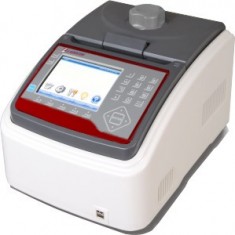Thermal Cycler Gradient LTCG-384-104
Labocon Thermal Cycler Gradient LTCG-384 Series with gradient technology have block capacities of 384 well plates. It uses precise temperature control and rapid temperature changes to conduct the polymerase chain reaction. It has an advanced Peltier technology, LCD display and independent operation of dual modules for protocol optimization. It is capable of performing more than 200000 cycles to create multiple copies of sample DNA which can be used for further downstream procedures. A maximum of 1000 programs can be saved and run with a maximum of 99 cycles in each.
| Capacity | 384 well |
| Peltier Quantity | 8 |
| Block Material | Aluminium Alloy |
| Temp. Range | 0-100°C |
| Temp. Accuracy | ≤±0.1°C |
| Temp. Uniformity | ≤±0.2°C |
| Heating Rate | 4°C/s |
| Cooling Rate | 3°C/s |
| Temp. Control | Block, Tube |
| Average Ramping Rate | 0.1-5°C |
| Hot-lid Temp. | 30-110°C |
| Hot Lid Height | Stepless Adjustable |
| Gradient Range | 1-30°C |
| Gradient Temp. Range | 30-100°C |
| Display | 5.6 inch, 640×480 Pixels, TFT |
| Display Resolution | 0.1°C |
| Graphical Display | Yes |
| Programs | 1000 files +(USB Flash) |
| Max. No. of Segment | - |
| Max. No. of Step | 30 |
| Max. No. of Cycle | 99 |
| Built in Interchangeable Programs | 6 |
| Power-cut Recovery | Yes |
| Temp. Acceleration/ Deceleration | 0.1-9.9°C |
| Time Acceleration/ Deceleration | 1 Sec-9 Min 59 Sec |
| Pause Function | Yes |
| Editing of File while Running | Yes |
| Support for USB Mouse | Yes |
| Support for Touch Screen | No |
| Connection | USB,Ethernet |
| Network Control | Yes |
| Auto-open Lid | No |
| Auto Data Protection | Yes |
| PC Control Software | Yes |
| Interface | USB2.0, RS232 |
| Power | 600 W |
| Power Supply | AC85-264 V, 47-63 Hz |
| Dimension | 390x240x260 mm |
| Weight (Kg) | 8.5 kg |
| Catalog No. | 9161119129 |
Labocon Thermal Cycler can be used for clinical diagnosis, DNA sequencing, gene manipulation, gene expression study, genomics comparative study and also in gene cloning experiment.
• Highly durable solid metal exterior
• Advanced Peltier-based semiconductor technology
• Step less adjustable lid that can adapt to different heights in vitro
• Tightly sealed working chamber ensures stability and reliability of experiment
• Windows operating system for ease of operation
• Interface: Bilingual curve, graphical
• Data can be stored and recovered on power or system failure


 Download Catalog
Download Catalog